HP Mini 5103: Looking at the Dual-Core Atom N550
by Jarred Walton on December 17, 2010 1:05 PM ESTHP Mini 5103 Performance
The big question we want to answer today is what sort of impact a slower core clock with a dual-core CPU has on performance and battery life. HP says that in general they’re seeing about a 20-25% performance improvement relative to the 5102, though that of course depends on what sort of applications you’re running. Here’s our standard set of general performance benchmarks.
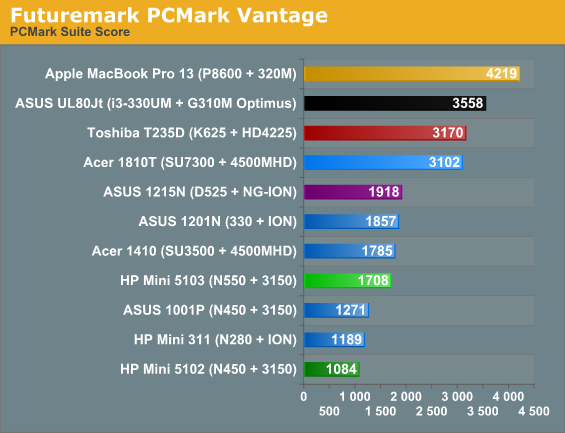
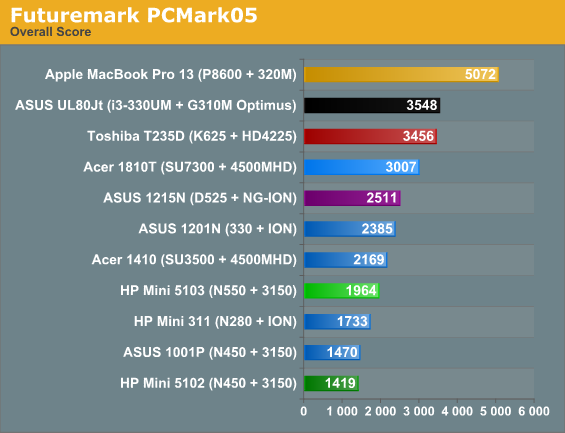
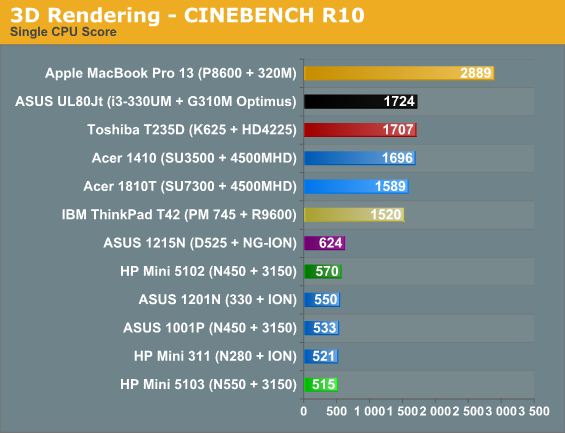
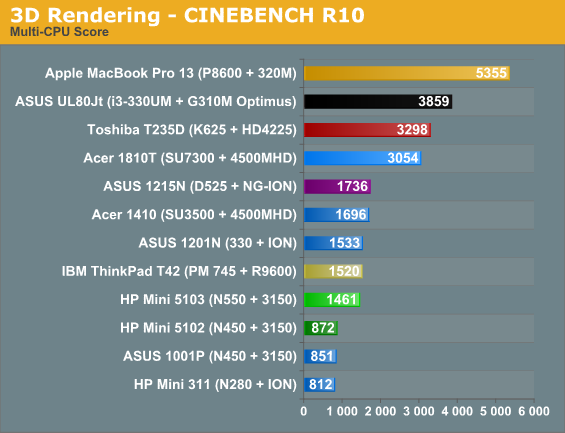
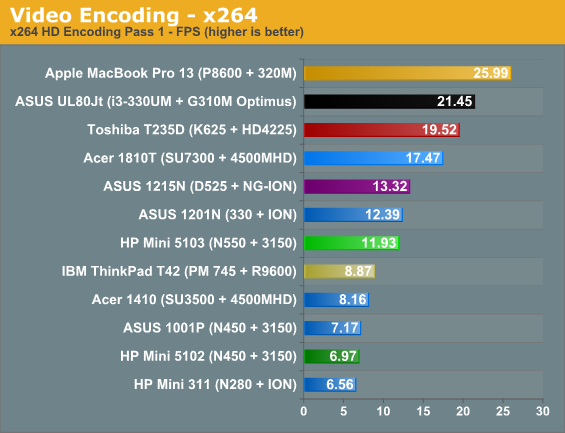
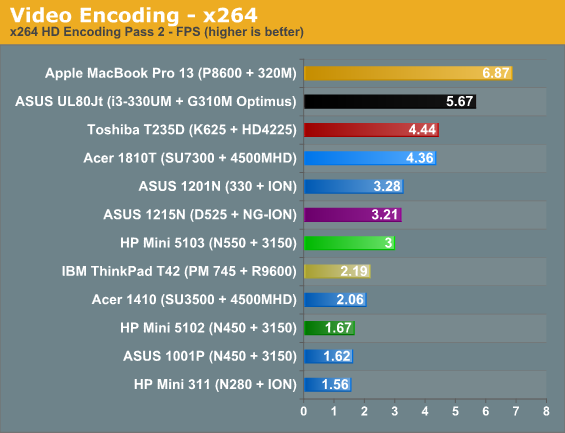
Our test suite tends to overemphasize multi-core processors, which means the dual-core N550 looks a lot better in the above charts than what you’ll experience in general. That’s why we include the single-threaded Cinebench result, because there are still plenty of times where that represents what you’d be doing with a PC, and in particular a netbook. The result is that there are times when the N550 is actually slower than single-core Atom CPUs, and there are other times where it can feel nearly twice as fast. PCMark Vantage ends up 58% faster than the 5102, PCMark05 is 38% faster, and our heavy-threaded testing is even better. Cinebench SMP is 68% faster, first-pass x264 encoding is 71% faster, and the second-pass x264 encode shows an 80% improvement. That’s the good news; the problem is single-threaded Cinebench is nearly 10% slower, and that does show up in general use.
I’ve used enough Atom netbooks to say that this is slightly faster overall, but it’s not a major performance increase. Instead, it’s a slight speed bump in most areas, and when you throw in results like that of an old 1.8GHz Pentium M 745 (i.e. the ThinkPad T42) there are a lot of applications where an old but fast single-core CPU still comes out on top. Windows 7 booted faster and was more responsive on a six-year-old T42 in practice, though like Atom netbooks it really struggles with fullscreen HD H.264 content (which is to say, it’s choppy and generally unwatchable). Unfortunately, I didn’t have enough time with the T42 to run PCMark, as I think the scores there would have shown more of what you see in the 1-CPU Cinebench test (perhaps not quite so dramatic, though).
You can also see a similar state of affairs when you look at performance results from the old CULV laptops like the Acer 1410 and 1810. The dual-core SU7300 completely eclipses the 5103, while the single-core SU3500 in the 1410 still beats the 5103 in every test other than x264 encoding. N550 does include support for SSE3, and that combined with Hyper-Threading gives it enough of a boost to come out on top in that particular test. Overall, however, the N550 can’t keep up. A more telling comparison is the Turion II K625, which boasts much higher overall performance for a lower price; if Brazos can offer a similar level of performance while cutting power requirements to Atom levels, the 2011 netbooks are going to be in for a nice upgrade at last.
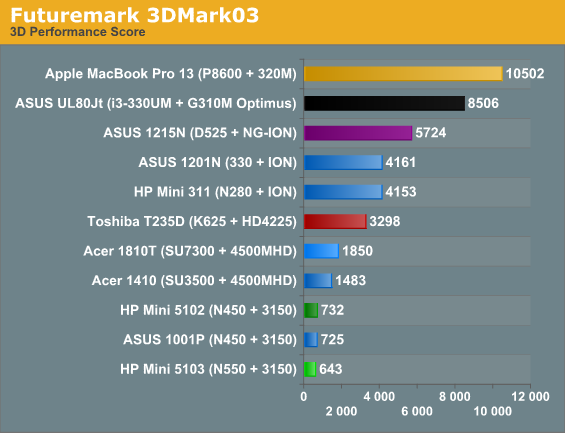
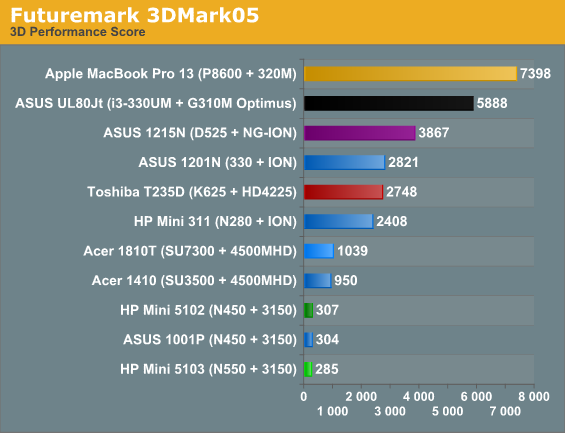
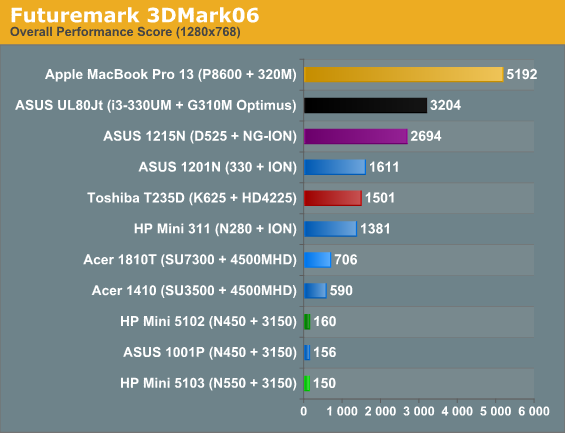
Atom on its own is unfit for most games released this side of 2000, so we didn’t bother with even trying to run any games. 3DMark tells the story well enough for our purposes: the HD 4225 in the Toshiba T235D is five to ten times faster than the anemic GMA 3150 IGP. We’ll have to wait for the next update to Atom to see if Intel is ready to put a bit more GPU performance into their inexpensive processor line. We’d expect they’re ready to make that move, considering AMD’s Brazos targets a similar market segment; if not, we may see a lot more netbook design wins from AMD in 2011.










57 Comments
View All Comments
puffpio - Friday, December 17, 2010 - link
Can I ask a question? Something I always wondered at Anandtech.When I flip from page to page in this review, the machines being compared in the charts are never the same. For example: The Macbook Pro is not included in the battery life charts but it's in the performance charts and display charts. But it's also never mentioned why the items in the charts vary from page to page..
I have noticed this in other articles as well. My first thought is that it would 1) skew the results too much to make the graph unreadable, or 2) the data is not available. But a more nefarious reason would be to cherry pick competitors to make the graph say what you want it to say.
Thanks for any insight
Stuka87 - Friday, December 17, 2010 - link
Hmm, I see the Apple MacBook Pro 13 in all the battery results?JarredWalton - Friday, December 17, 2010 - link
The simple explanation for data missing from various reviews is that we either didn't have it, or we didn't choose to include it in a particular review for one reason or another. For laptops, if we've reviewed a laptop in the past, the usual reason it's not included is simply to avoid bloating the graphs. We have an "unofficial" decision to try to keep graphs to around 10 items to make them readable (at least for laptops). So, as we review new laptops we sort of arbitrarily remove older units from the charts. I try to keep relevant items in the charts, though, which is why the 5102 is there, along with single-core CULV, dual-core CULV, the i3-330UM UL80Jt, 1215N, 1001P, etc. -- basically one each (at least) of the various platforms.As for how the charts are created, I do need to take some time at some point to make things easier. Right now, we use spreadsheets with results for the various laptops. I have netbook, entry, midrange, and high-end spreadsheets floating around -- multiple revisions of each. Vivek and Dustin have the same thing. So when it's time for a new article, I need to try to collate results from two or three spreadsheets, then add in the results for the test laptop. It's a bit of a pain, and that's why Vivek and Dustin often include different laptops in their reviews.
So now, after writing this, I think I'm going to go fool around with a database and see if I can make something that will handle all our needs better....
pjkenned - Friday, December 17, 2010 - link
$700 for a dual core Atom netbook versus $1,000 for a Macbook Air 11.6" (base). It would be cool to see a comparison because the larger 13" Apple designs are targeting full-feature notebooks instead of ultraportable/ netbooks.vol7ron - Friday, December 17, 2010 - link
I think this netbook has the right idea w/ features. I also think it's $200 more than what it's base and configured prices should be. I wonder if there would still be a profit if they knocked $200 off the price."just in case you want to watch a 1080p H.264 movie on your 10.1” LCD"
The article makes it seem like no one would want this. I had a portable DVD player that was smaller than this. I would like this feature. It's especially nice for on-the-go, or people who work at places that have a lot of downtime.
JarredWalton - Friday, December 17, 2010 - link
You can do 720p fine without the CrystalHD was sort of my point. Anyway, I'm not saying the ability is bad, but I'm saying the cost for that feature is too much. $100 to do a configurable model, and then $45 more for CrystalHD. I'd rather just get an NG-ION chip in there, or a CULV laptop instead.vol7ron - Monday, December 20, 2010 - link
I agree with this statement. While I don't have a problem with 1080p, I'm not sure why it's being pushed so hard. 720p is still acceptable, especially given the price differential as you mentioned.While I somewhat understand the nature of the dimensions (small device + wide keyboard + 1080p for HD video), I still do not completely understand why this is the majority decision.
Still, great article, great product, just hopefully they'll find some way to knock the $$ down.
blueboy_10 - Thursday, December 23, 2010 - link
Exactly. I'd jump at the chance to have an 1215N over this netbook, simply for the fact the fact that it has ION it. I'm a little annoyed over the fact that it does hit on battery life, but really it doesn't impact on the battery life as much as I thought, cause my Toshiba Satellite iCore 3-eqipped has about roughly the same amount of battery life as the 1215N does, so I'm not really losing anything. BTW, the CULV laptops are very good in comparison, but I like the smaller footprint that these netbooks provide. Don't get me wrong, this machine is a sound machine with basic features, but there are better choices out there for the price. It's good to check around for prices on the net, who knows, you might find a good deal. This is my thoughts on this. - BLUEBOYTaft12 - Friday, December 17, 2010 - link
I'd love to see 768 vertical pixels become available on more netbooks, but if you can buy 3 other netbooks for the price of this one, a vendor has forgotten the definition of the word netbook.Don't blame the dual-core CPU for inflating the price, the 1K unit price of the N550 is $22 more than N455.
This will be the marketplace failure it deserves to be.
mino - Friday, December 17, 2010 - link
On another note, why are there exactly zero SoC Atom's in Bench?Also, why do you generally not include mobile CPU's in Bench?
I mean, what are 10 flavors of Athlon II X2 good for with no numbers for e.g. K625 ?
Same goes for i* stuff.